| |||||||
| Search Forums |
| Advanced Search |
| Go to Page... |
 |
| Search this Thread |  963,269 views |
| | #976 | |
| Distinguished - BHPian  | Re: My Car Hobby: A lot of fiddling, and some driving too! Jaguar XJR, Mercedes W123 & Alfa Romeo Sp Quote:
A couple of little jobs this week, First thing I had to fix was my old trusted multimeter. I have at least 5-6 multimeters, and that is before I start counting my little museum collection of classic multimeters. But I have one favourite, that always sits at my workbench at the ready. I must have owned it for well over forty years I think. The other day I had a problem with one of our smoke detectors in the house. Usually that is just a battery that needs renewing. I always check the battery voltage before replacing it. But my multimeter was completely dead! So I opened it up. Just four little screws at the back. 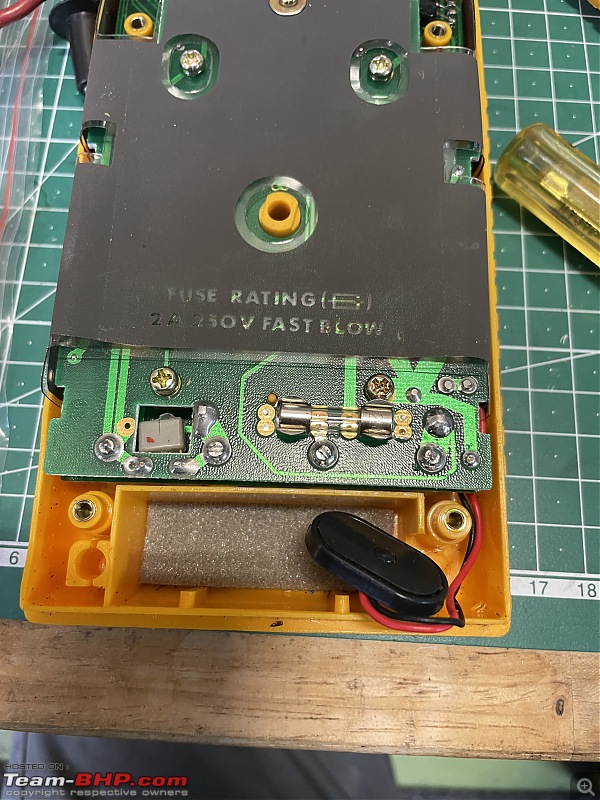 Sure enough the 9V battery was dead! You donít need a multimeter to test a 9V battery, you can just hold it against your tongue!! I canít even begin to remember when I last changed the battery. These multimeters use very little current and I donít use my multimeter that much either. In the old days, batteries would leak if you would leave them in your devices too long. That might still happen, but I am always amazed at these modern batteries how long they last without any problems. But I also noticed that the (glass) fuse had popped! This is a 250V/2A fast fuse. Not sure how that happened. You canít really blow the fuse with normal voltage and or resistance measurements. Only when you try to measure amperage. Which I havenít done for a long time. Anyway, long rummage through hundreds of glass fuses. 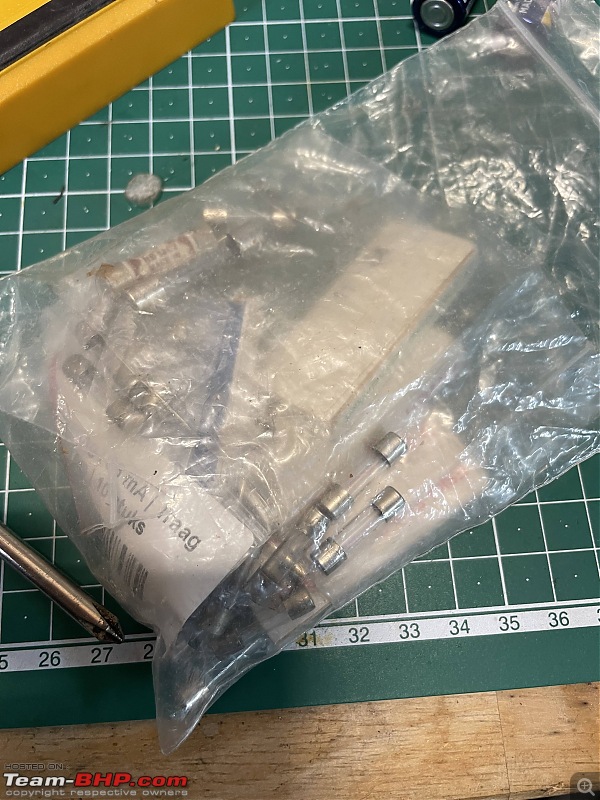 Did not have the correct rating. So down to the local car part store. Who sold them individually! So multimeter fixed. Whilst at the part store I also bought this special car window kit. 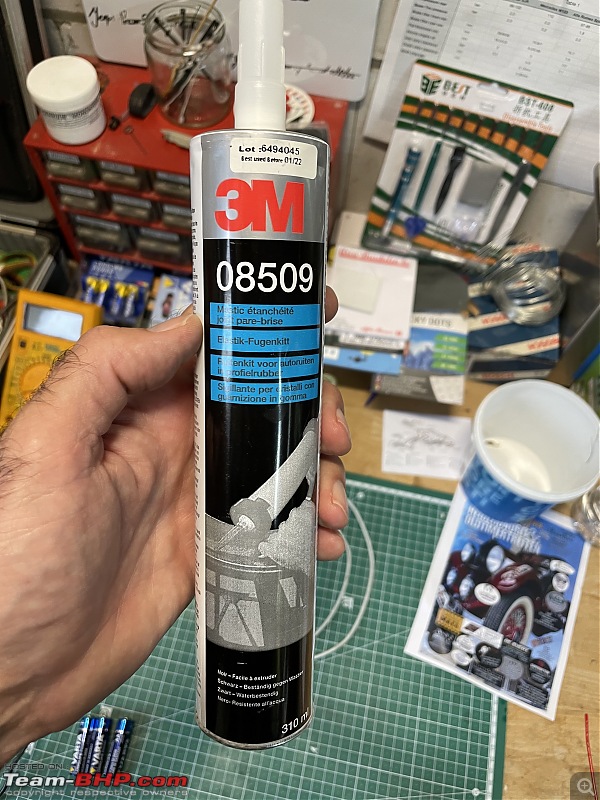 As you might recall I noticed a little leak in the rear window of my W123 a few weeks ago. Many years ago I replaced the rear window seal and had the various metal (rusty) bits cleaned and repaired. So the seal is still good, but I decided to just put some kit inside the corner of the seal. Because that is usually where the leak is as water can collect there. 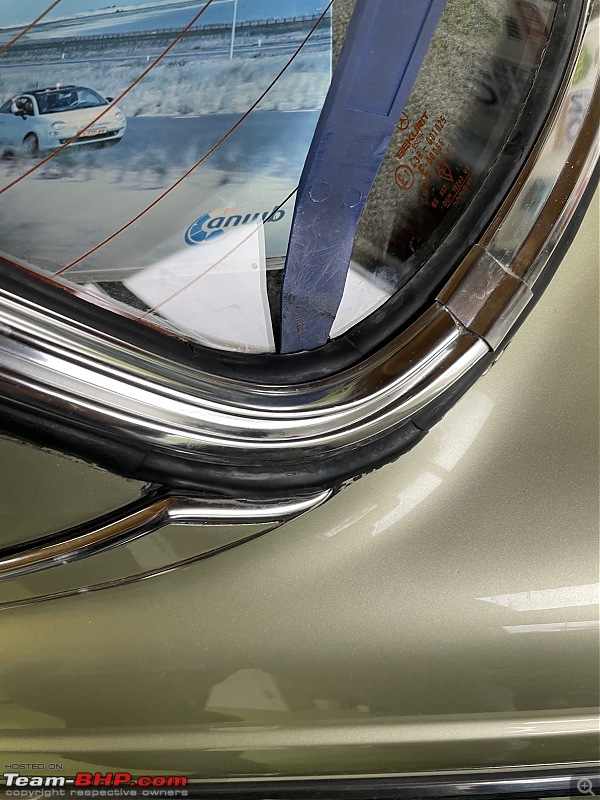 We will see if this has made a difference. Spanner mate Peter is coming over on Thursday. He might bring his Spider that needs a couple of little jobs doing. Also, we want to check the movement of all the pistons on the Jeep and do a proper compression test. And, time permitting, we might do some work on the Jaguar. For the compression test I need a sort of extension for the adaptors for the compression meter. I had some brass that would work, but I also needed the correct die and taps. Spark plugs have standardised thread. There are a few different sizes, but the most common is M14x1,25 (Fine metric) I have quite a number of dies and taps, but nothing of that size!! 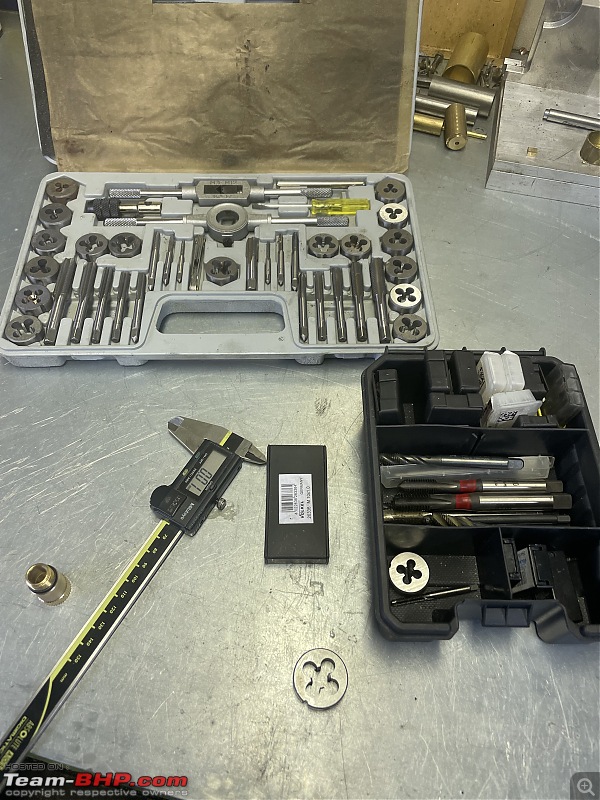 So I ordered some and they arrived today. Than I realised I donít have the holder for these large sizes either. 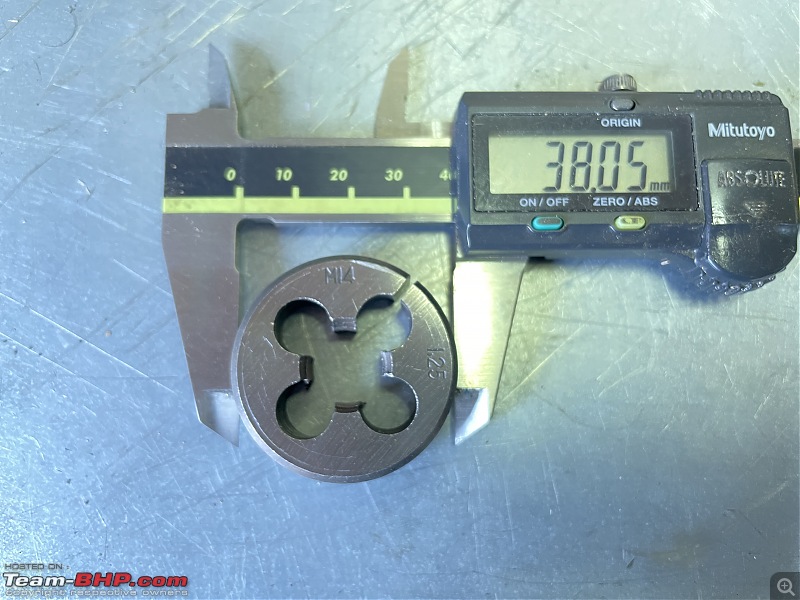 But I figured I could make it work anyway. Here the new tap set. These taps come in sets of 2-3. You can see a little ring mark on one of them. That is the first tap you need to use. If you have a set of three, there will be one with two of these rings. 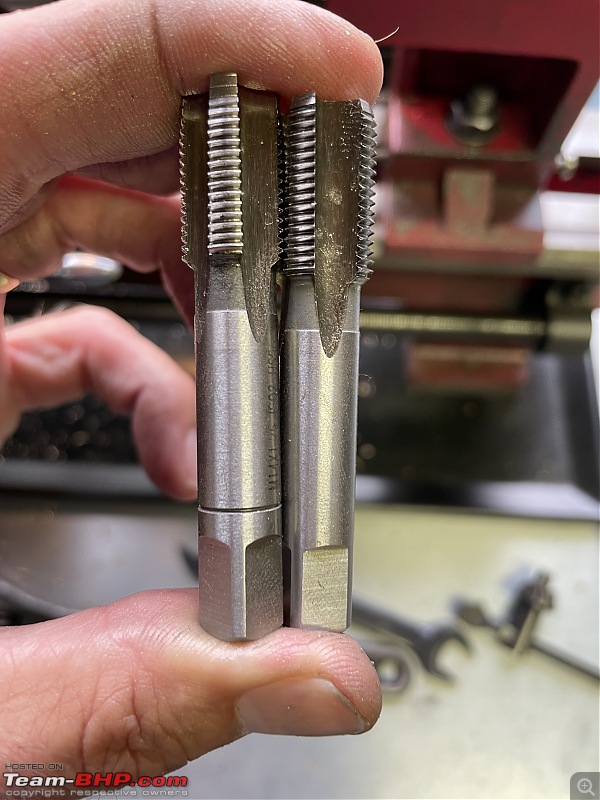 Jeroen | |
| |  (6)
Thanks (6)
Thanks
 |
| The following 6 BHPians Thank Jeroen for this useful post: | CosmicWizard, IcarusMan, Prowler, Thad E Ginathom, vaasu, VivekCherian |
| |
| | #977 |
| Distinguished - BHPian  | Re: My Car Hobby: A lot of fiddling, and some driving too! Jaguar XJR, Mercedes W123 & Alfa Romeo Sp I thought I would just show how I made this little adaptor for my compression tester. It is one of the reasons I got my little lathe in the first place; to make parts for my cars. I found a piece of brass round stock that was long enough for this purpose. Put it into the lath and faced it off. Next the centre drill. 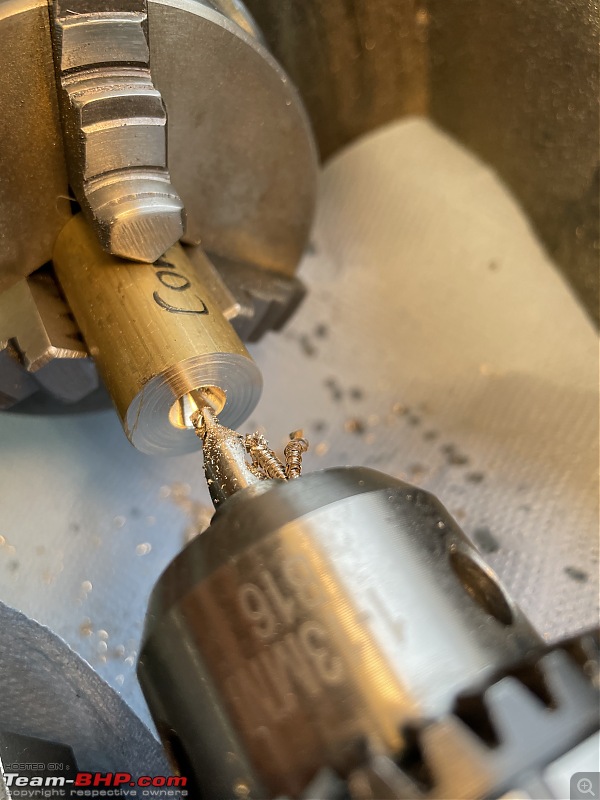 The inside diameter for a M14x1,25 thread is 12.9mm. I donít have a drill that size, so I drilled 12,5 mm first. 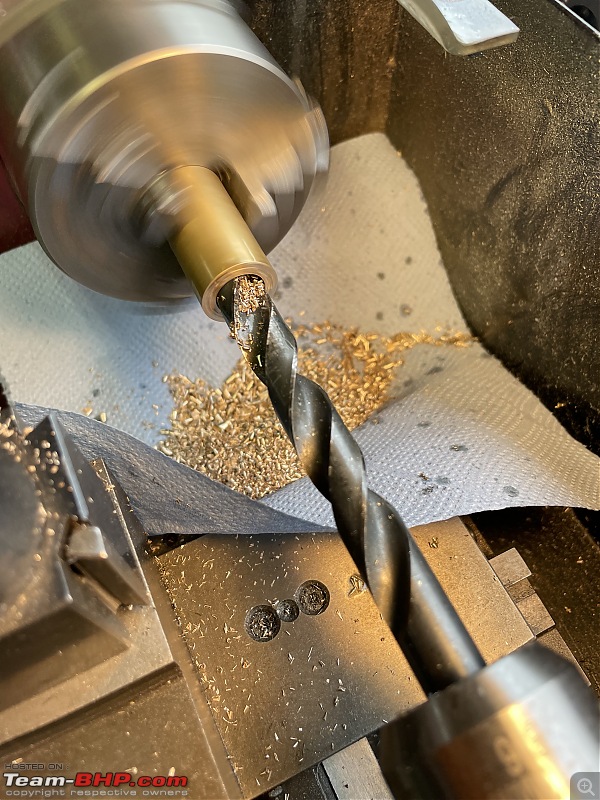 Next I used an inside cutter (you can just see it on the right bottom corner) to widen it up to 12.9mm. 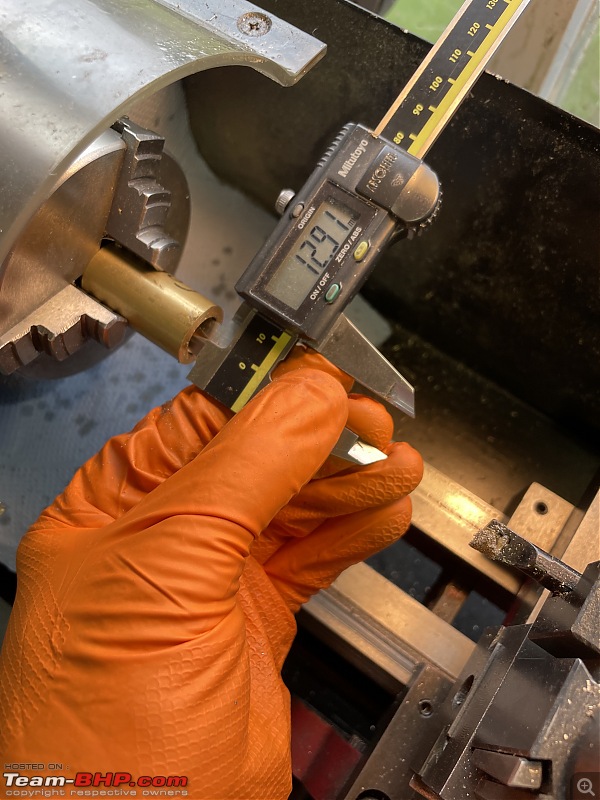 Next a bit of chamfering on the outside and on the inside, that is where an O-ring needs to make seal. 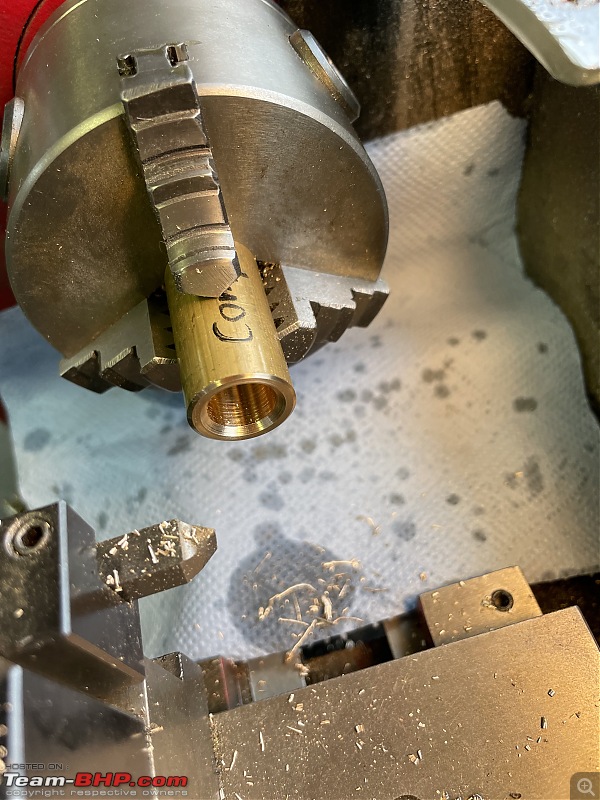 Looks good! 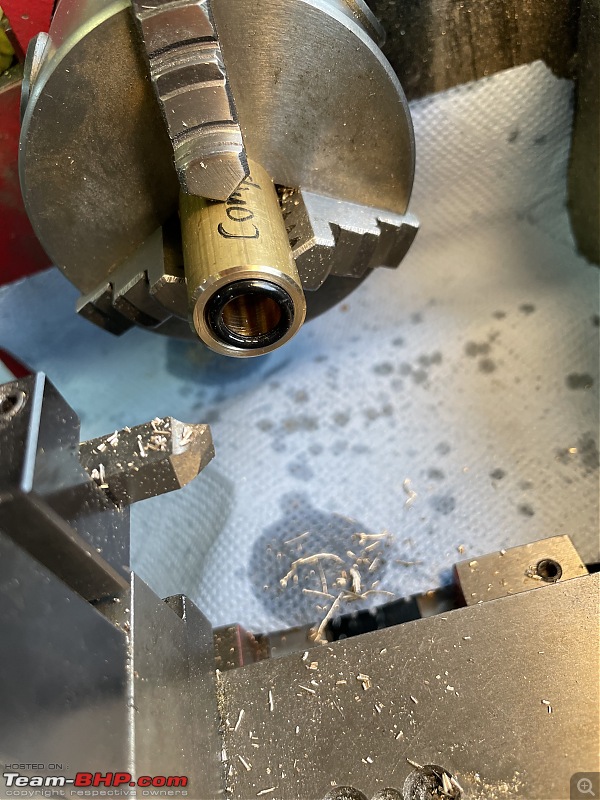 On the other side of this piece of brass I need to make outside thread. So the outside needs to be turned to the correct size for M14x1,25mm. 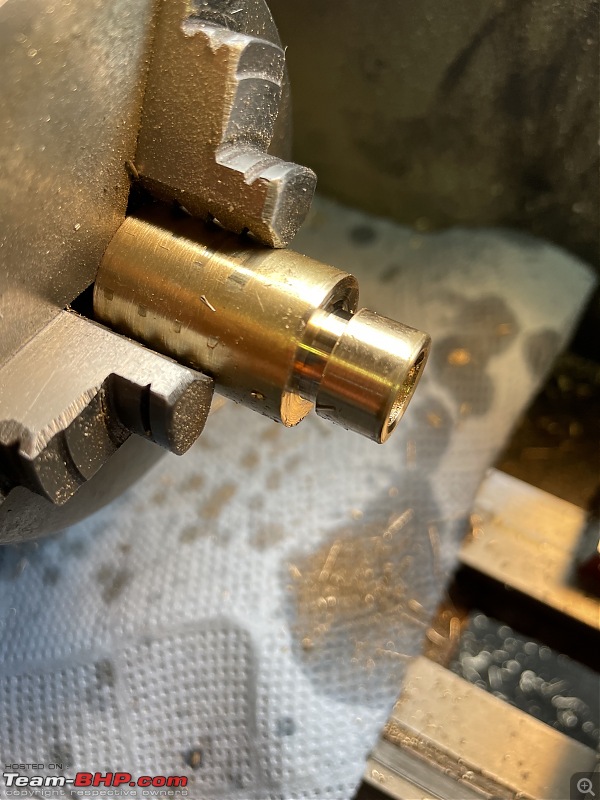 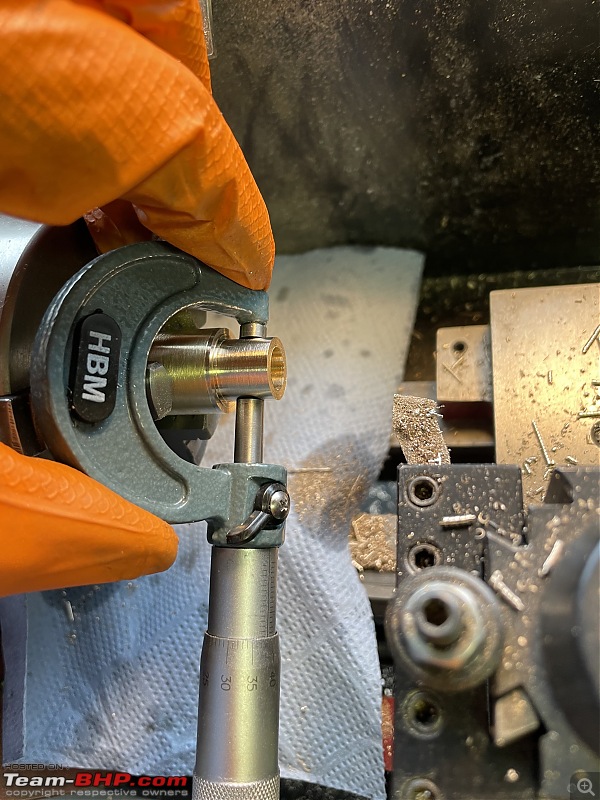 A bit of knurling, so you can hand tighten this adaptor easily. 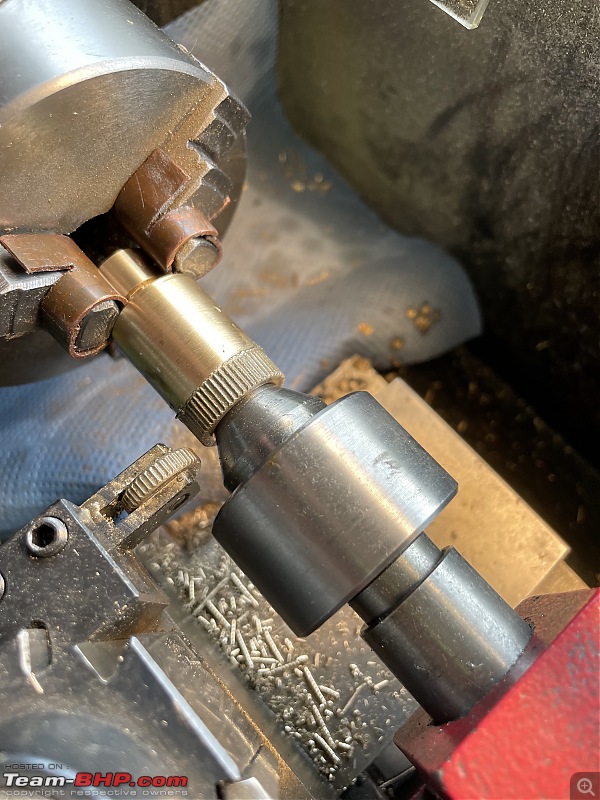 Next, make the internal thread with my new tap! I am also using my special tap follower. A very simple device that (by means of spring loaded centre) keeps pressure on the tap. 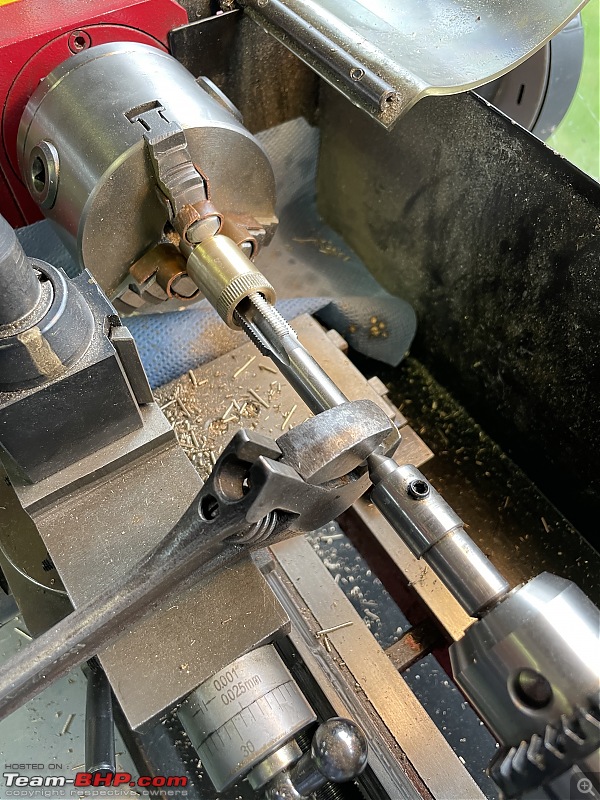 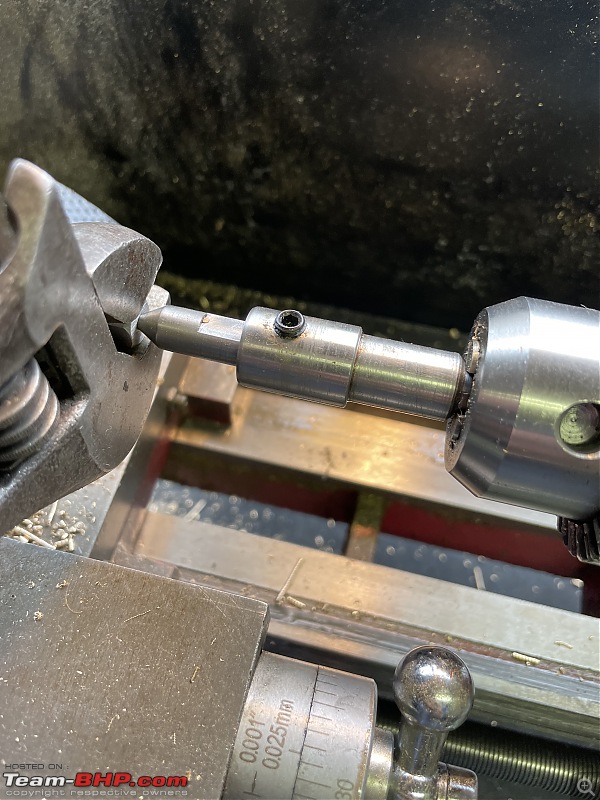 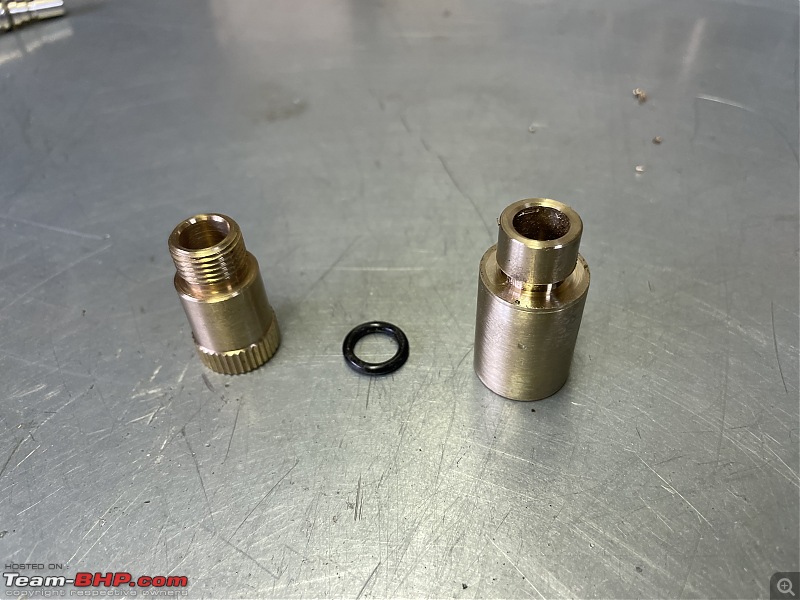 Looking good! 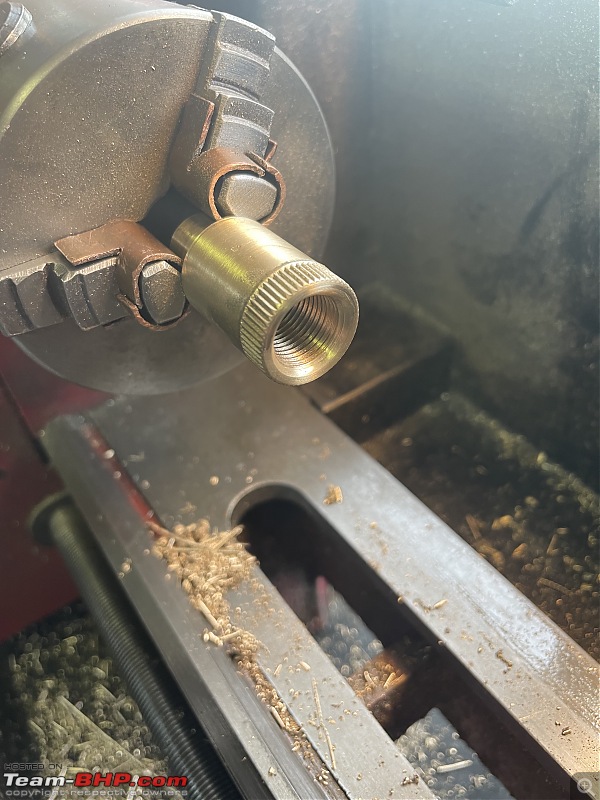 The outside thread was little bit more difficult. The larger the size the more difficult it becomes. Because a die comes in one size, it can be difficult to get it to engage properly, so you might mess up the first few threads. I also have a special tool to support the die, but again too small for this die, but I can use it in the lathe to apply pressure to the die plate. Also, very happy I have bought these large pliers recently as they come in handy for this job. 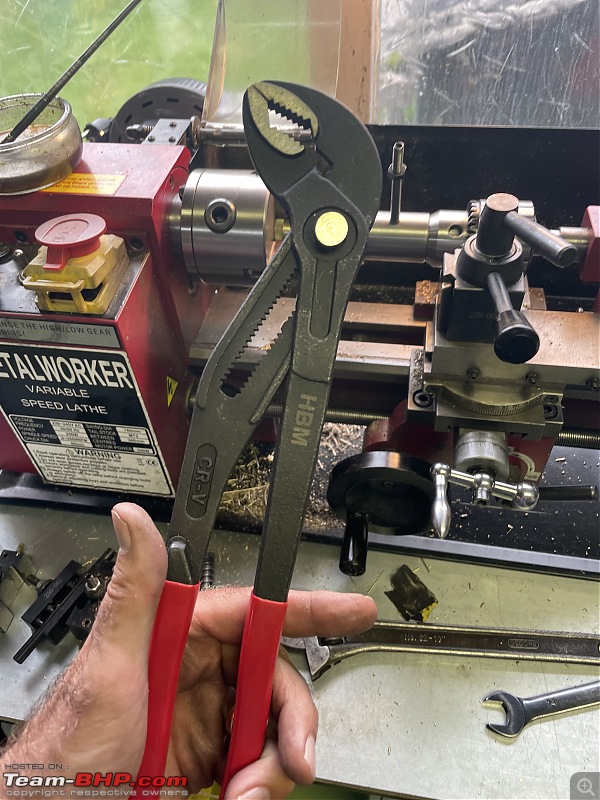 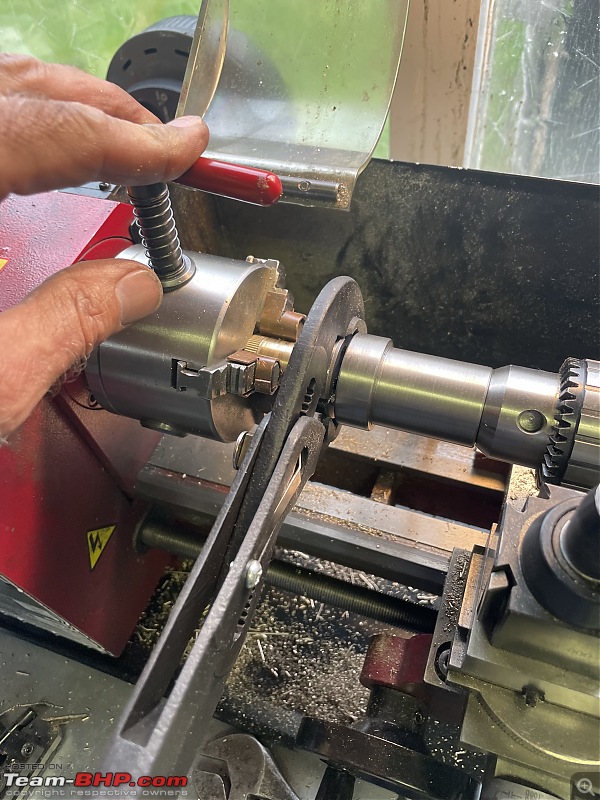 Took a bit of fiddling and quite a bit of force, but it worked well in the end! 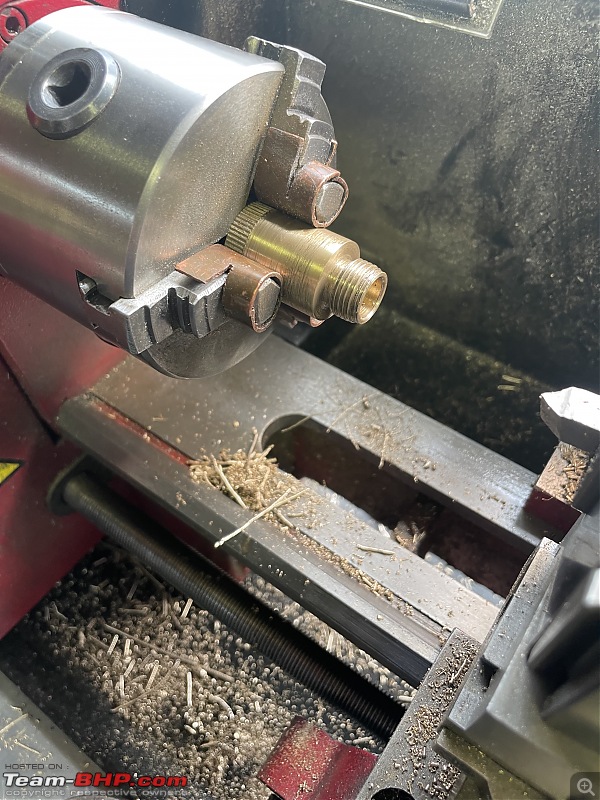 A bit of final polishing and so, one adaptor ready! 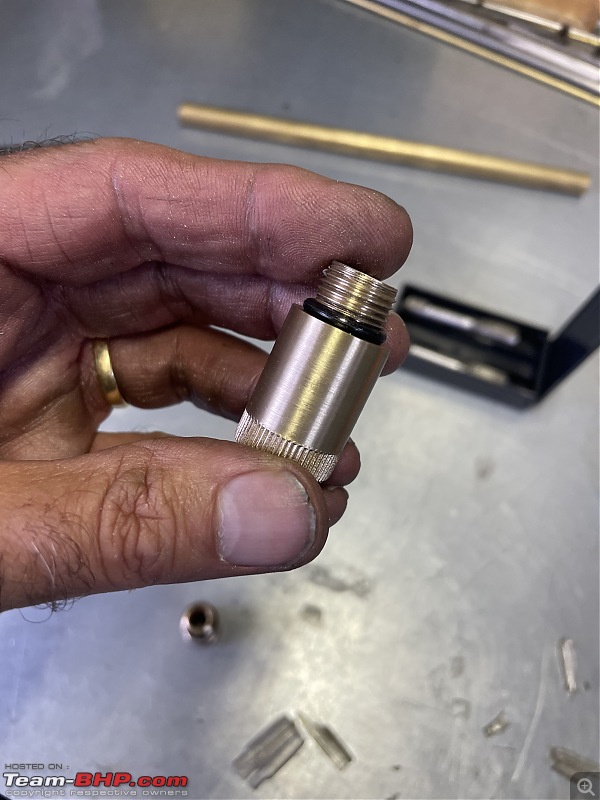 The old and the new one 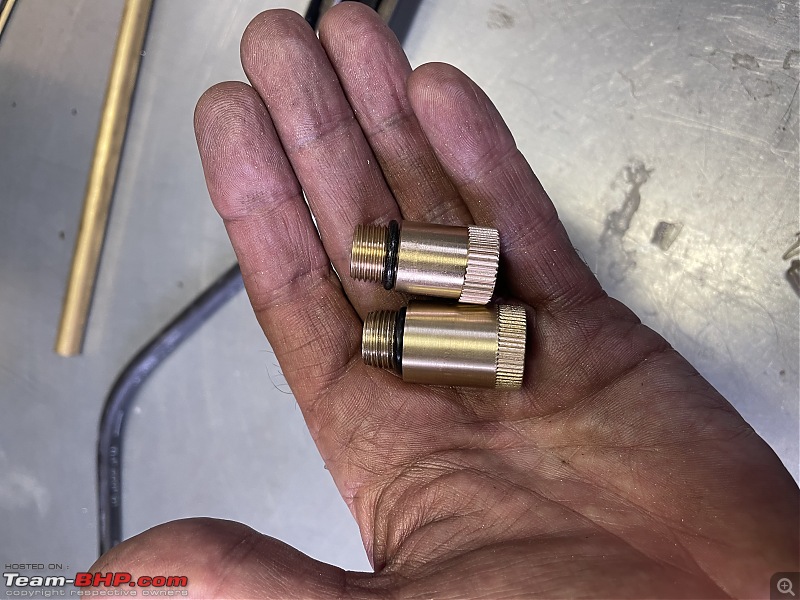  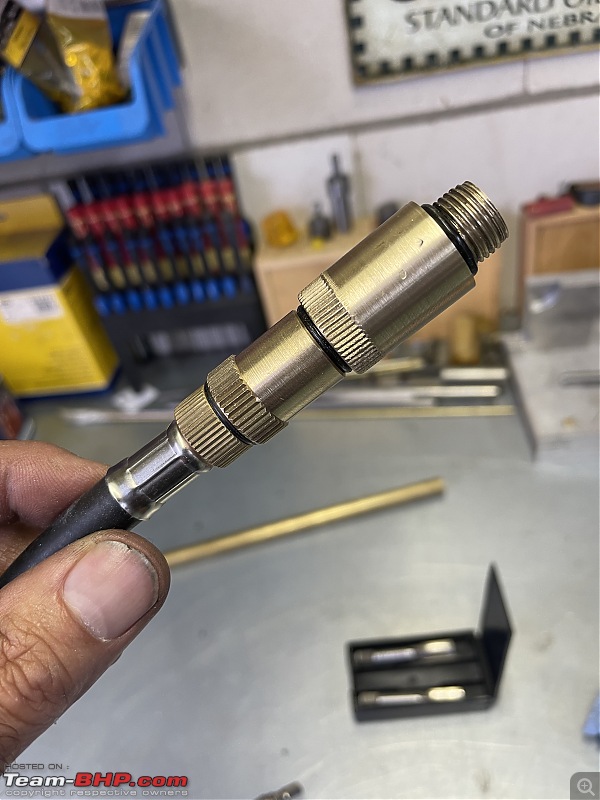 I can now use one or two adaptors. That should give us enough options to get into the various spark plug holes. I will most likely use some locktite to connect these things all together. All of this should fit and be tightened by hand only. The problem is you will be able to screw it into the spark plug hole, but as you try and undo it, the adaptor might get stuck. In order to get it out it means taking the valve cover of, which is quite a job on the Jeep. Interestingly the new die and tap cost more than the complete compression tester with four adaptors!! Jeroen Last edited by Jeroen : 7th October 2022 at 21:12. |
| |  (7)
Thanks (7)
Thanks
 |
| The following 7 BHPians Thank Jeroen for this useful post: | carthick1000, IcarusMan, Prowler, SS-Traveller, Thad E Ginathom, VivekCherian, wbd8779 |
| | #978 |
| Distinguished - BHPian  | Re: My Car Hobby: A lot of fiddling, and some driving too! Jaguar XJR, Mercedes W123 & Alfa Romeo Sp I have mentioned this before. One of the (many) interests of Mrs. D is period dress. She makes her own, and often for friends as well. She is particularly interested in sort of Jane Austin / Regency period. One of the reason she loved being in India is because she could buy endless amounts of all kinds of gorgeous cloth and make period dresses. Last Friday evening she got a call from the chairman of the local Meriton Society. He had been approached by the organisers of the Bockbier festival in Zutphen. they needed some more Regency dressed participants to ride on one of the stage coaches. Would she be interested to join? Of course, because Mrs. d loves this thing. We both love Zutphen. It is an absolutely gorgeous little town on the river IJssel. My eldest sister Hilde has lived there for over thirty years. So on Sunday morning we fired up the Mercedes W123 and drove to Zuthpen. There are endless kinds of Bockbier events and festivals all over this part of the Netherlands. Also in other countries. Bockbier is a special kind of dark lager, brewed after the harvest. The council of Zutphen organises all kind of events to celebrate this event. One being a huge parade of classic vehicle. Anything goes, as long as it is very old. And I mean really old. I took a little video. You will see classic motor cycles, classic cars, many classic horse and carriage combinations, endless classic tractors and even a couple of steam tractors. I took this image just before Mrs D and her friends boarded the stage coach, Mrs D being the second from the left. Unfortunately her shoes were not the correct ones, period wise. In her defence, they came apart as we got into the Mercedes W123. So she had to rush back into our home to get another pair. 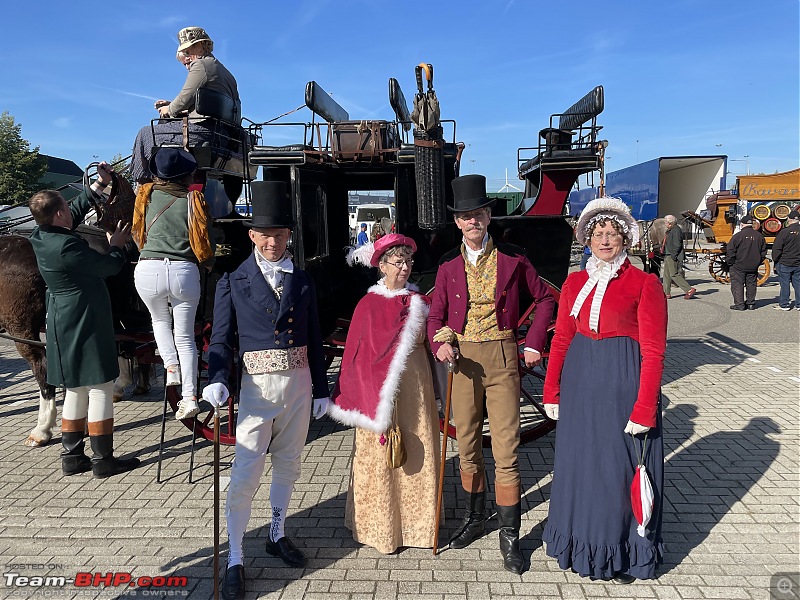 Hilde and I positioned ourselves strategically on one of the nearby corners where we could see the complete parade coming by. Notice how Mrs. D is waiving very “queen/bored like” until she recognises us amongst the pleb!  Hilde and I walked into town and came across the parade a few more times. These Bockbier festivals are huge and the town square had been filled with a Beer market where you could sample the different kinds of Bockbier. Which we did, obviously! I can’t show any of the images, as everybody was holding a glass of bockbier, all over Zutphen. If you ever visit this part of the Netherlands I can highly recommend visiting Zutphen, irrespective of festival. It is a very pretty and nice town. Very pleasant to just walk around with many quite unique shops. And if you visit Zuthpen dont forget to visit the Gallery on the other side of the river. https://www.gallery-aaldering.com Enjoy! Jeroen Last edited by Jeroen : 10th October 2022 at 22:36. |
| |  (8)
Thanks (8)
Thanks
 |
| The following 8 BHPians Thank Jeroen for this useful post: | carthick1000, Freespirit27, Prowler, rrsteer, sagarpadaki, vb-saan, VivekCherian, wbd8779 |
| | #979 | |
| BHPian Join Date: Jul 2008 Location: Madras
Posts: 775
Thanked: 1,329 Times
| Re: My Car Hobby: A lot of fiddling, and some driving too! Jaguar XJR, Mercedes W123 & Alfa Romeo Sp Quote:
| |
| |  (1)
Thanks (1)
Thanks
 |
| The following BHPian Thanks Prowler for this useful post: | Jeroen |
| | #980 | |
| Distinguished - BHPian  Join Date: Jun 2007 Location: Chennai
Posts: 11,005
Thanked: 26,447 Times
| Re: My Car Hobby: A lot of fiddling, and some driving too! Jaguar XJR, Mercedes W123 & Alfa Romeo Sp
I'm not good at this sort of thing so I had to google. Quote:
 I had no idea that there was a thousand years of middle ages! I was thinking maybe 300. History lesson day for me! | |
| |  (2)
Thanks (2)
Thanks
 |
| The following 2 BHPians Thank Thad E Ginathom for this useful post: | Jeroen, Prowler |
| | #981 | |
| BHPian Join Date: Jul 2008 Location: Madras
Posts: 775
Thanked: 1,329 Times
| Re: My Car Hobby: A lot of fiddling, and some driving too! Jaguar XJR, Mercedes W123 & Alfa Romeo Sp Quote:
It is a visual treat to watch these magnificent animals gallop in grassy plains. Sorry Jeroen Sir - to divert attention from your wonderful narrative. | |
| |  (1)
Thanks (1)
Thanks
 |
| The following BHPian Thanks Prowler for this useful post: | Jeroen |
| | #982 | |
| Distinguished - BHPian  Join Date: Jun 2007 Location: Chennai
Posts: 11,005
Thanked: 26,447 Times
| Re: My Car Hobby: A lot of fiddling, and some driving too! Jaguar XJR, Mercedes W123 & Alfa Romeo Sp Quote:
They are big powerful animals, used for harder work that pulling a couple of humans. In England, I think the horses used for pulling the carts loaded with beer barrels might be called dray horse (google confirms). I do not know if cart horse and dray horse are exactly synonymous. My mum would have know. But think of them as low-gear heavy-load carriers, not highway cruisers. The carriages in the video, I'd guess at being 19th-centuary. I wonder if some of the beer carriers are actually in use now? There may yet be a brewery or two in England that uses them, if only for show, for local deliveries. I doubt that there is any five-hundred-year-plus vehicle on any road, but will now google something like "oldest vehicle still used on road." Let's find out! Jeroen, any of your breweries still do horse+cart delivery? | |
| |  ()
Thanks ()
Thanks
 |
| | #983 | |
| Distinguished - BHPian  | Re: My Car Hobby: A lot of fiddling, and some driving too! Jaguar XJR, Mercedes W123 & Alfa Romeo Sp Quote:
We have stopped using the wooden beer caskets a long time ago. All aluminium these days. And some pubs donít even use those. They just have a massive tank in the cellar that gets filled by a tanker. Jeroen | |
| |  (2)
Thanks (2)
Thanks
 |
| The following 2 BHPians Thank Jeroen for this useful post: | Prowler, Thad E Ginathom |
| | #984 |
| Distinguished - BHPian  | Re: My Car Hobby: A lot of fiddling, and some driving too! Jaguar XJR, Mercedes W123 & Alfa Romeo Sp Yesterday spanner mate Peter came over. He was supposed to bring his Spider as we were going to do some small jobs on it. However, the weather was pretty horrible, so he left his Spider home and came in his Jaguar XJR X350. Only one tiny job to be done as you will see. We had decided to redo the compression tests on the Jeep. This time with the help of my newly DIY adaptors, so we could get proper readings. As it turned out the original adaptor would not fit at all! Could not figure out why. It looks fine, the dimension are fine, the thread is fine. Very weird. Luckily, Peter had brought his compression meter too and that worked fine. So just the spark plugs taken out and the two relais (ASD and fuel) and we re did the compression test. We also checked each and every cilinder/pistion with my little scope. We did not see any pistons wobbling. And the compression test came out real good! Cylinder 1,2,3,4 and 6 were all between 170-175 PSI. Cylinder 5 was 190 PSI. As you might recall, Toon and I thought it might be Cylinder 5 that has the piston slap. We also listened again with my stethoscope. I still think cylinder 5, but Peter thought it was cylinder 5. Irrespective, there is nothing I am going to do with this piston slap problem for the time being. The compression seems really good for an engine that has run over 300K!! 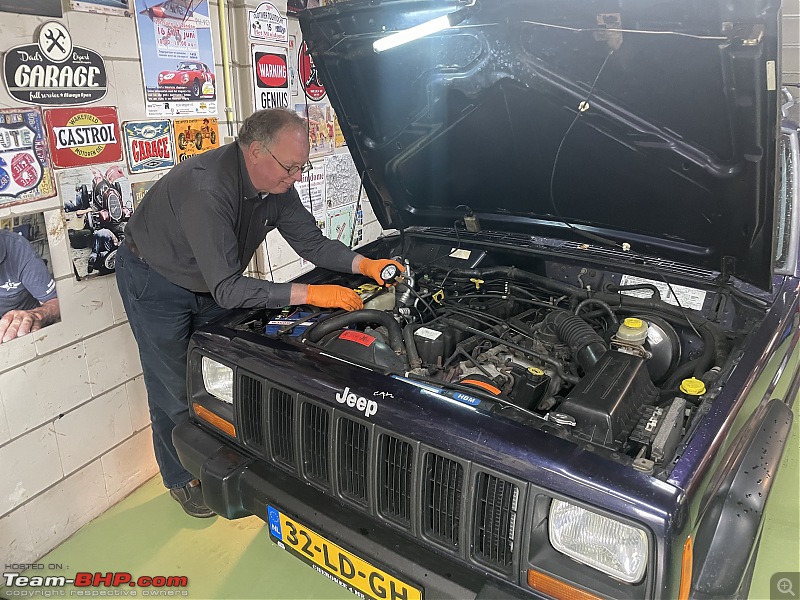 Next we decided to tackle the rubber ball joint sleeves on the Jaguar. As you might recall the Jaguar did pass his earlier annual MOT with no problems, but it was noticed that the sleeves had deteriorated. So up on the jacks/and axle stands, wheels off. 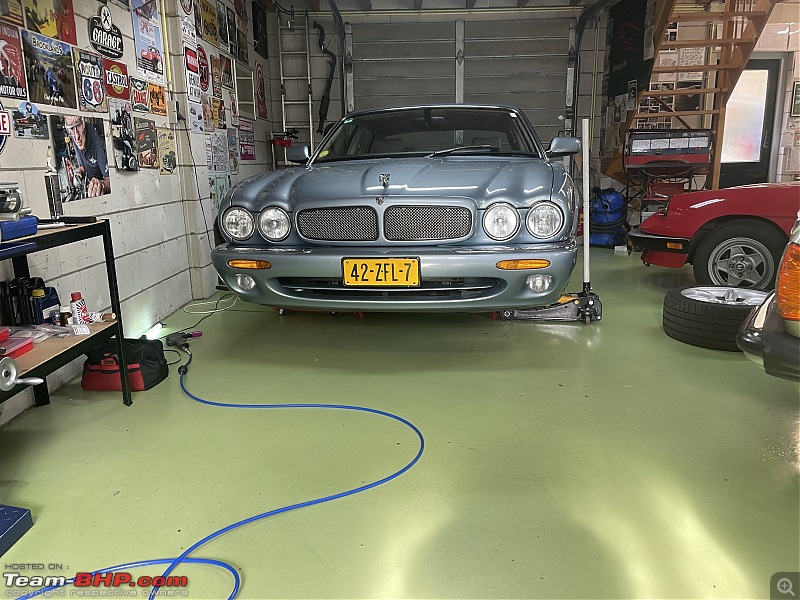 It is important to have both front wheels of the ground. If not, the stabiliser bar will put additional force on the opposing wheel and suspension component hanging in the air. With this method you can safely disconnect the ball joints without worrying about the springs. Out comes my trusted splitter. 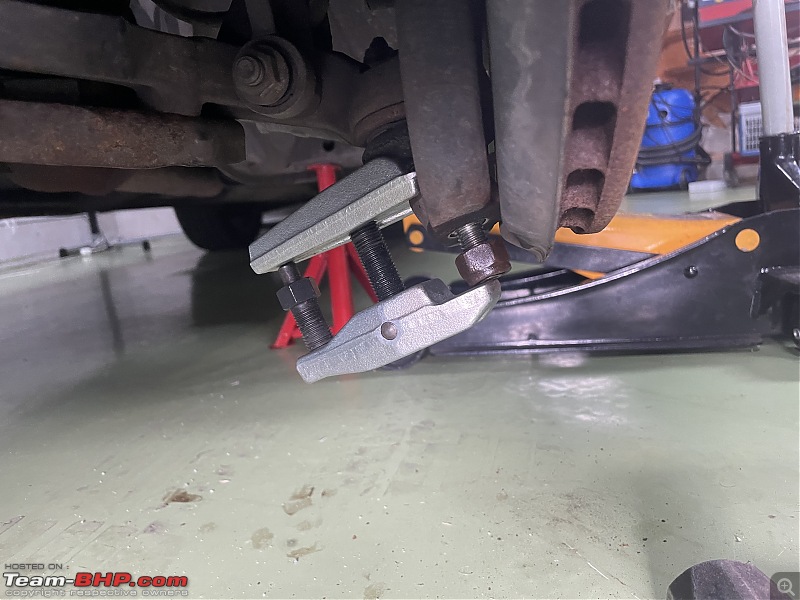 Initially we could not get this one (left) undone. The splitter kept sliding out as we tightened it up. Which usually means you need to cut the sleeve away. Problem was, we had no new ones yet. It is becoming increasingly more difficult to find these sleeves separately. I knew a couple of places that have a large box with all kinds of sizes. So we had to bring one with us. But if we failed to find new ones, the old ones had to go back on. So we tried the right hand size and that one popped off very easily. Here you see the old one and you can clearly see the cracks. As long as the cracks are on the outside and not through and through its considered ok. If it is cracked in-outside it is an immediate MOT fail. Apart from the MOT you just donít want to be driving around with these sleeves in poor state. Water will get in, the ball joint start getting corroded and very quickly you will have substantial play. Replacing a ball joint can be a complex and expensive affair. Remember I did one on the W123 some years ago. Huge pain to get the ball joint out and back in. 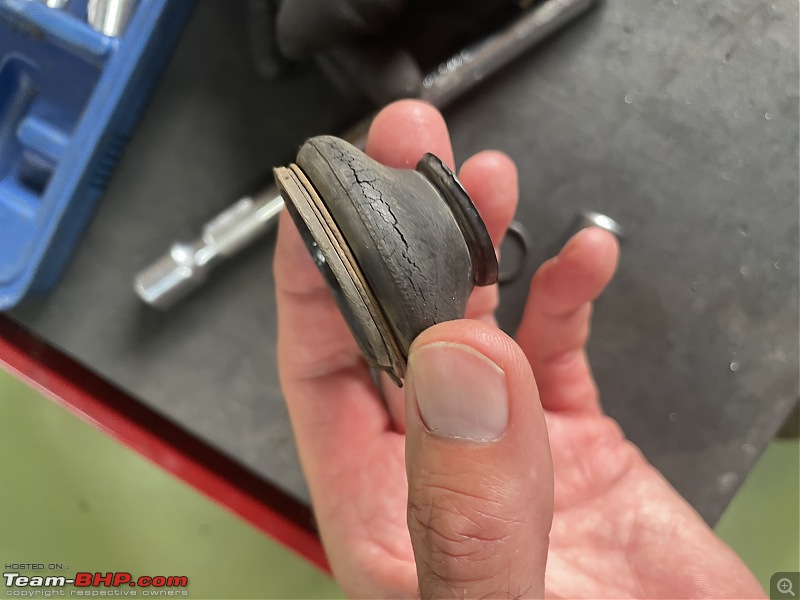 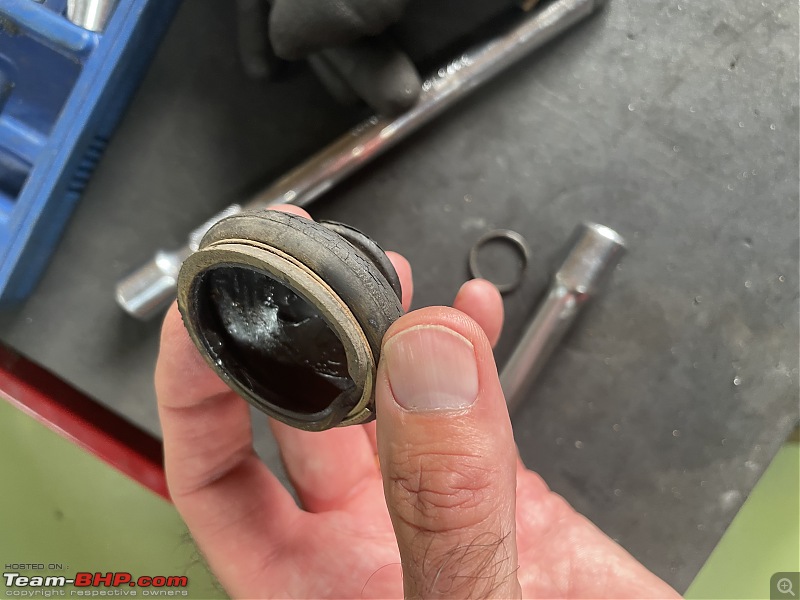 With one ball joint off and the sleeve in our pocket we went on search for new ones. Luckily we found some nearby at a car parts store. They are not identical, but close enough they will work and fit properly. Before slipping the new sleeves on, I fill them up with general purpose grease. 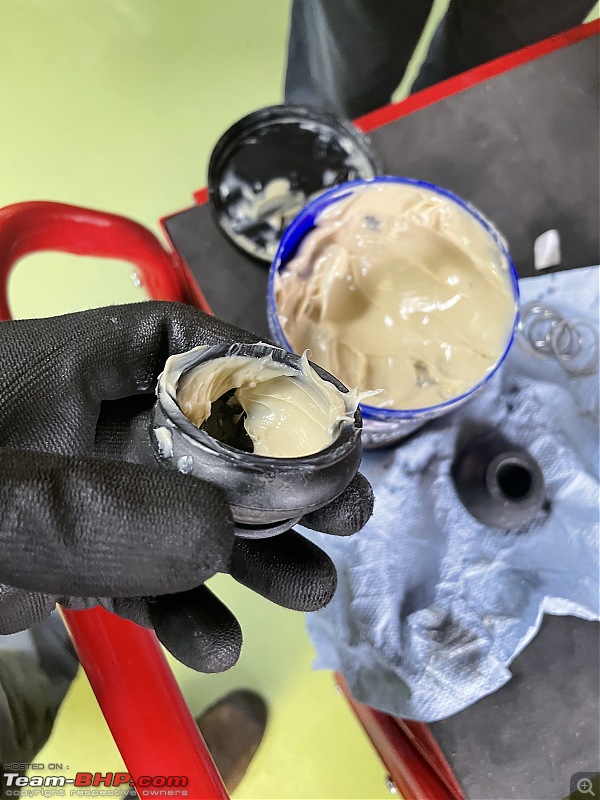 To get the ball joint thread out of the lower suspension, we had to jack up the suspension against loaded spring. Not much, only about 10mm, that was all that gave us sufficient clearance. 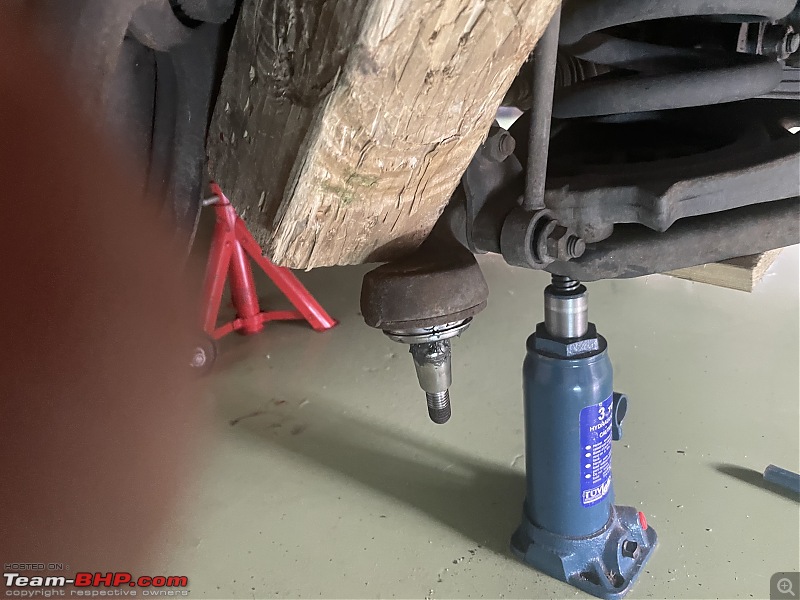 Here you see the new sleeve fitted correctly 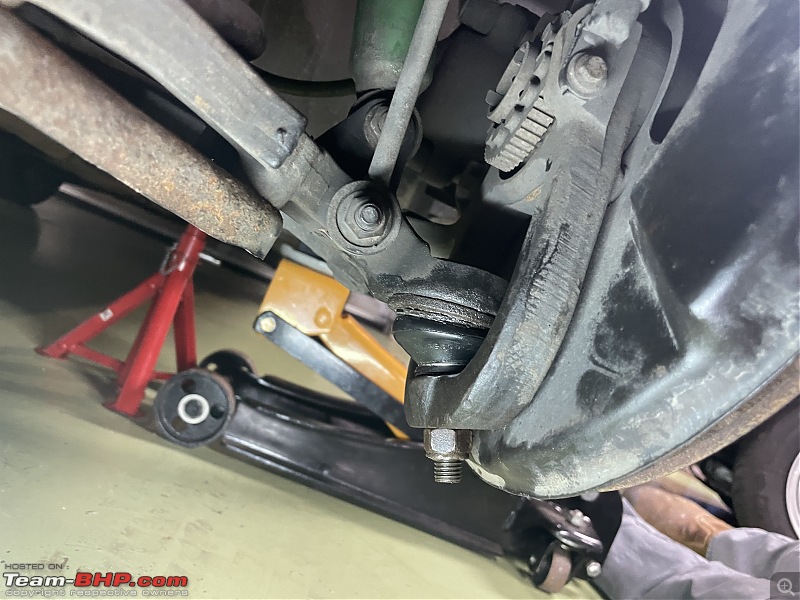 Notice, I never undo the nut completely. I turn it till it is about flush with the top of the thread. That way it will protect the thread from the splitter. Also, when it pops off, the nut will ensure nothing gets launched across my garage.  The biggest pain was securing the sleeves with some special springs. Pain to get them on, but we managed in the end. Finally torque the nuts to 70Nm. 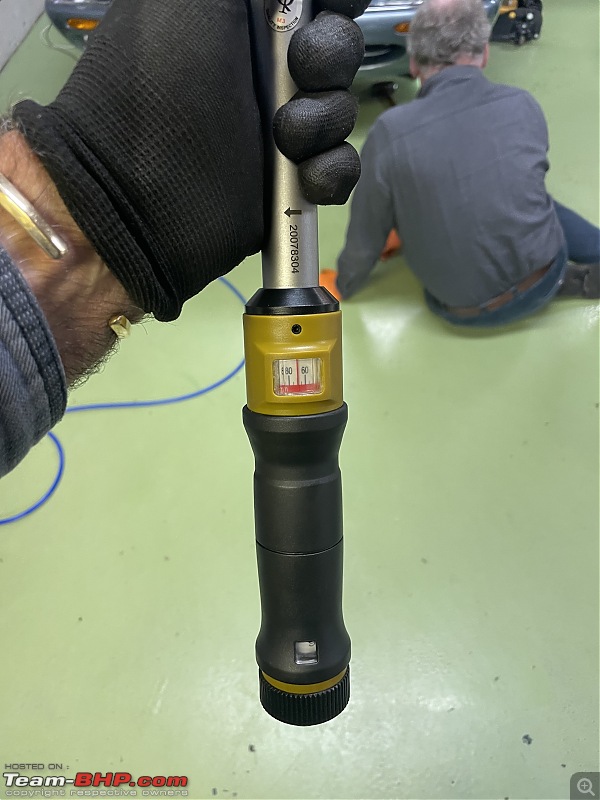 Peter being very technical underneath the front of the Jaguar. 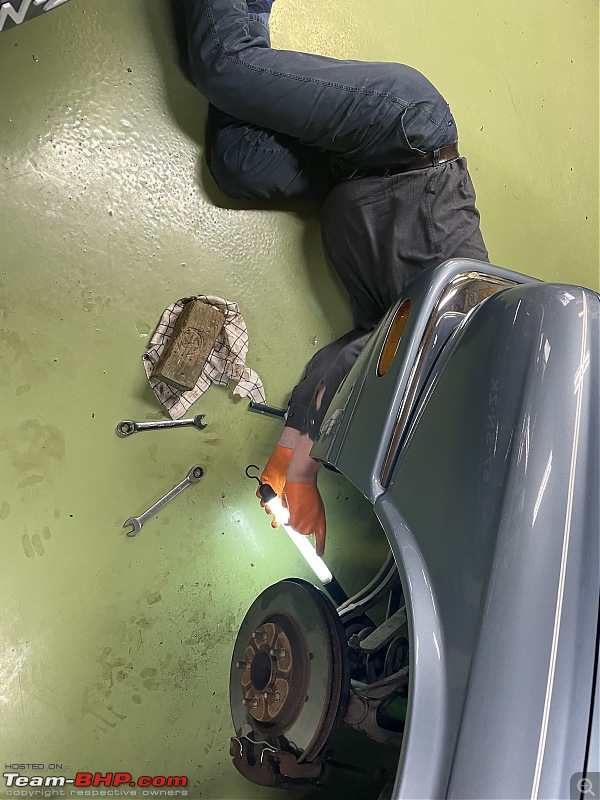 We cleaned the discs with brake cleaner, just to be safe. We had been working with a lot of greasy bits, so better make sure everything is free of grease and oil, especially the discs. 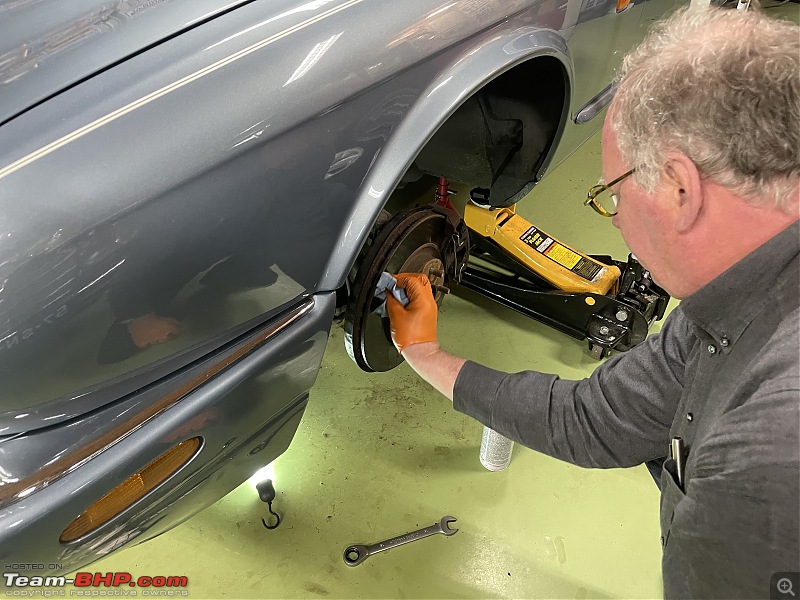 We took it for a quick test drive. Nothing out of the ordinary. I will need to get the alignment checked sometime in the near future, but the car drives very well, keeps straight, no vibrations and so on. Finally a simple job on Peterís Jaguar. Peter wanted to install a wired power supply for his TomTom GPS unit, but one that is switched via the ignition switch. We thought there might be one wire in the engine compartment that might be a switched positive. If you look carefully you will see a very pointy device underneath the red multimeter terminal. You can just push that into the wire, it leave a tiny hole, that you just tape over. 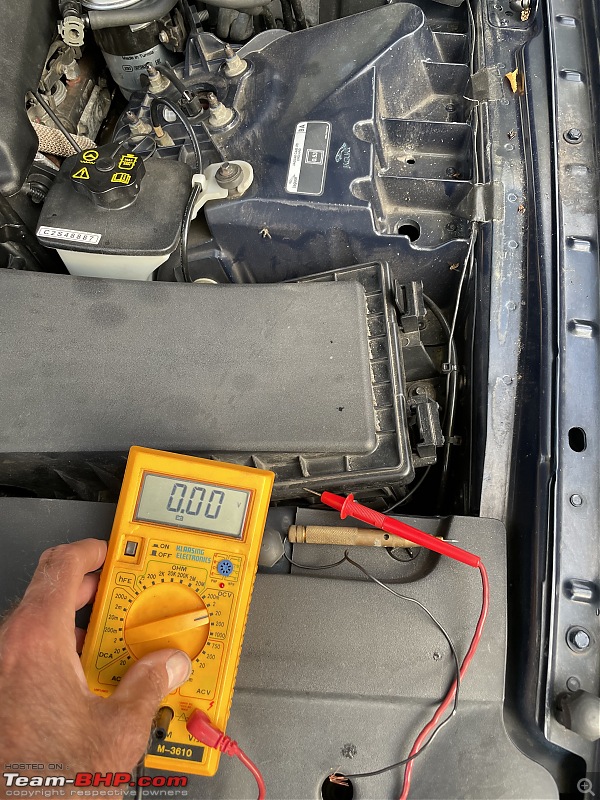 The problem with these modern cars is that it very difficult to get access to things. So we could not get to this wire near any of the connectors easily. So we checked and unfortunately it appears there it is not a switched positive. So we need to think of something else some other time. Jeroen Last edited by Jeroen : 14th October 2022 at 16:44. |
| |  (9)
Thanks (9)
Thanks
 |
| The following 9 BHPians Thank Jeroen for this useful post: | Fuldagap, IcarusMan, InControl, OPMaurya, Prowler, sagarpadaki, Thad E Ginathom, vaasu, VivekCherian |
| | #985 |
| Distinguished - BHPian  | Re: My Car Hobby: A lot of fiddling, and some driving too! Jaguar XJR, Mercedes W123 & Alfa Romeo Sp We have just returned from a 14 day family visit to the West Indies. When I got home I found this letter, all in Dutch Iím afraid. I had been waiting for it though. 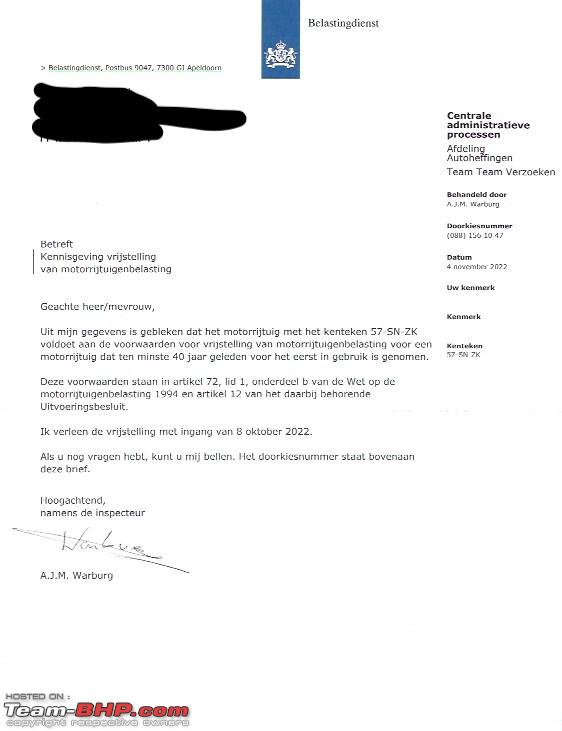 It is the official letter from the Dutch tax office that my W123 has turned 40 years on 8th of October. Which means going forward I do not have to pay any road tax on it. Under the current regime, I only had to pay one quarter road tax, but it was not allowed to be on the public road from 1st of December till 1st of March. That limitation has now been lifted as well. I have also made arrangement to have my Spider Steering Box overhauled in January/February 2023. It is going to be a major job removing it. Next week Friday spanner mate Peter and me will be visiting the technical day at G&G, run by Raymond. I have posted several stories on his amazing workshop before. The weekend after that Bernd and me will be visiting Interclassics exhibition in Brussels, Belgium. Peter has also bought a very nicee 1996 Lancia Dedra 1.8 Quite a rare car these days. He found out that it had been owned originally by friends of us from the Spider club! Small world indeed. He took it round the other day to show it to them. He has been doing some small jobs on it already. I have been trying to support him remotely from the other side of the world.  I had used my Jeep to take us to the airport and it had been parked there at the valet parking for the last two weeks. About a day before we were due to fly back I got an email from them, saying it would not start due to an empty battery. I gave them permission to jump start it and it was fine. Not sure what happened there. As you will recall, both the alternator and battery have been replaced. I can only think of a few things. Either it has picked up some parasite drain, or the valet-guys accidentally turned the ignition into the service position. That is one click beyond the normal off-position. Things like radio, power windows, lights etc can still be used with the engine controls completely switched off. Irrespective I need to check, probably next week or so. This weekend busy, on Saturday a workshop on soldering in my garage and Sunday I will be visiting the Flight Simulator event at Lelystad airport. I will probably be driving the W123. So plenty of fiddling and car related stuff in the weeks to come!! Jeroen |
| |  (15)
Thanks (15)
Thanks
 |
| The following 15 BHPians Thank Jeroen for this useful post: | --gKrish--, carthick1000, digitalnirvana, GForceEnjoyer, IcarusMan, InControl, keroo1099, KuvamBansal, OPMaurya, Prowler, s4ch, sagarpadaki, vaasu, vb-saan, VivekCherian |
| | #986 |
| Distinguished - BHPian  | Re: My Car Hobby: A lot of fiddling, and some driving too! Jaguar XJR, Mercedes W123 & Alfa Romeo Sp Those of you that follow this thread will remember I had some serious issues with my Jeepís battery and alternator about three months ago. In the end I replaced them both. The battery had a broken cell and the alternator brushes were worn down Overhauling would cost about the same as a new alternator, so I got myself a new alternator too. As you might recall the brand new alternator had a problem too, which I traced back to a bearing, so I got a new replacement alternator. Since, no problems whatsoever. I use my Jeep pretty regularly, or at least once a week. So I was surprised to get an email the other day from Amsterdam Airport Valet parking. I had left my Jeep there 12 days earlier. They wanted to move my Jeep and found the battery empty. I gave them permission to start it using a booster. The next day I arrived at Amsterdam, Jeep started with no problems and seems to be running fine. So today I decided to investigate what could have been the cause of the drained battery at the airport. I decided for a couple of very simple measurements first. I have one of these quick disconnect knobs installed on my battery. It has a little fuse across it, to keep radio settings and so on when you disconnect it by turning the green knob. I took the fuse out, connected my multimeter before and after the disconnect, so by turning the knob (disconnecting) any current will go through the multimeter. Here you see it with the knob still in the connecting position, so no current obviously. 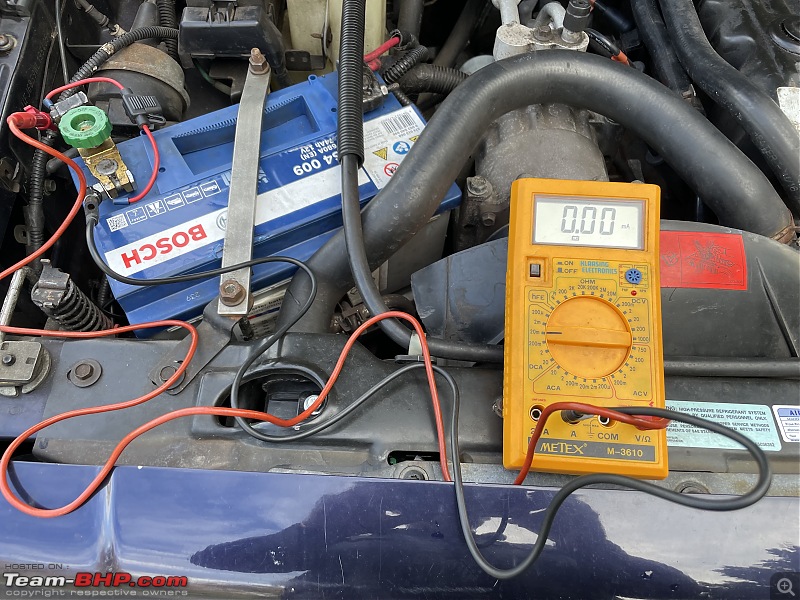 Next, I closed the doors, ensured the internal lights were off, ignition in the off position. I get a reading of 26,1mA. 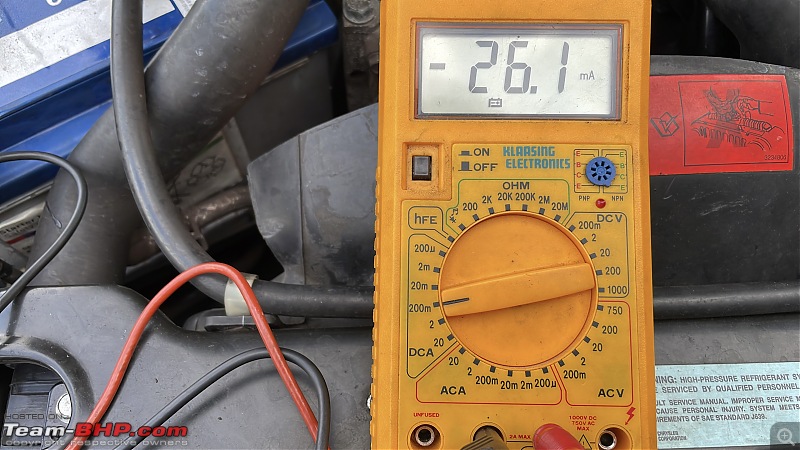 Next I do the same but with the ignition in the ACC position. I get a reading of just over 1A! 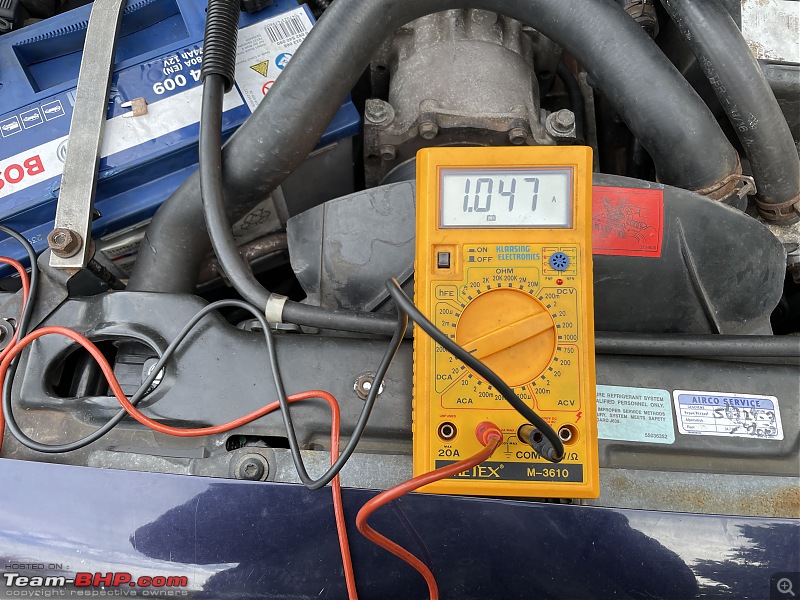 My suspicion is that the valet guy put it into ACC, rather then off position. The ACC position is a special position where all accessories remain powered, but not the engine as such. Not many cars here in the Netherlands have such an ACC position. The ignition key mechanism is a bit worn as well, so it is not always easy to feel in which position you are. It would certainly explain how the battery became drained. I am still stuck with a couple of questions though: With everything off, is 26mA a low enough value? My car does not have an alarm/immobilizer. My 1986 Alfa Spider with immobiliser draws about 35mA. I was sort of expecting the current to be a little lower. But of course at 26mA my new battery (74Ah) will last a really long time. I am wondering how much current should I have in the ACC position? 1A seems a bit much, what is actually powered. I know the radio can be turned on, but with the radio turned off, the additional current is negligible. With the radio on I measure another 600mA or thereabouts. I know I can operate the electric windows in ACC. Maybe my ignition key mechanism is a bit wonky and something is shortening. I might have to consider the classic ďfind the parasite drawĒ by pulling the fuses one by one. (Or measuring voltage drop over the fuses) So I need to be a bit more research going to the Jeep forums and pouring over electrical diagrams. Jeroen |
| |  (8)
Thanks (8)
Thanks
 |
| The following 8 BHPians Thank Jeroen for this useful post: | carthick1000, digitalnirvana, GForceEnjoyer, IcarusMan, InControl, Prowler, Thad E Ginathom, VivekCherian |
| |
| | #987 | |
| BHPian Join Date: Jul 2008 Location: Madras
Posts: 775
Thanked: 1,329 Times
| Re: My Car Hobby: A lot of fiddling, and some driving too! Jaguar XJR, Mercedes W123 & Alfa Romeo Sp Quote:
For example, I checked my cars and they show about 10 mA in one and about 30 mA in another. If the car is not used for a few days, the latter comes down to about 12 mA. The additional current drawn is to keep the small LED triggered to warn that the immobilizer is on. The CPU decides that if the car is not used for some time, it goes into slumber mode reducing the quiescent current. So that 26 mA may not be a big issue if it is the standard quiescent current for your car. But anything above a few hundred mA is surely something that needs investigating. For cars without any control electronics, even tens of mA need some probing. A diesel ISUZU engine in my ancient Ambassador drew no current. | |
| |  (5)
Thanks (5)
Thanks
 |
| The following 5 BHPians Thank Prowler for this useful post: | digitalnirvana, IcarusMan, Jeroen, Thad E Ginathom, VinsWagen |
| | #988 |
| Distinguished - BHPian  | Re: My Car Hobby: A lot of fiddling, and some driving too! Jaguar XJR, Mercedes W123 & Alfa Romeo Sp Yesterday we had a little workshop in my garage. A couple of years ago, during the pandemic I had taken part in a course in brazing. A friend, Ruud, from a model engine forum and I had signed up. We had a very interesting day. Ruud and I had been doing brazing by ourselves since, mainly on (steam) engines and a few other bits and pieces as well. But both of us felt we could do with a bit of a refresher and also a little bit more advanced techniques and get some help with the parts where we often struggled. Our old teacher was still available. Initially we tried to get some other model engine friends interested, but in the end it was only us two. So rather than having to rent a workshop, we decided to have it in my garage, which worked out great. I moved the Jaguar and the Alfa Spider out of the way and used my two tables for the day. One for the actual brazing and one for all the stuff, tools, parts etc that our teacher had brought. And he brought a lot of stuff and left a lot of it to Ruud and me at the end of the day. 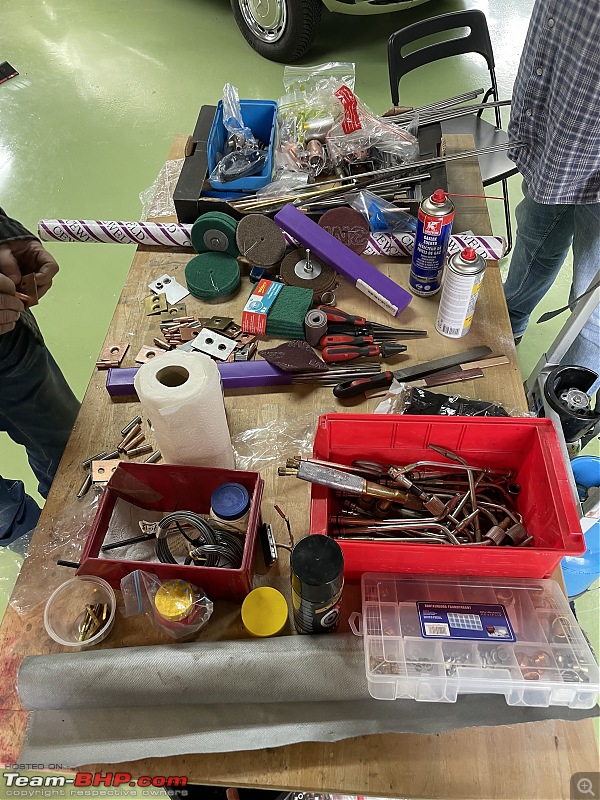 There is a difference between brazing and soldering. Funnily enough in Dutch we only have one word for it. Solderen. Although for brazing we add hard, so hard soldered. If the metal bonding process uses a filler metal that melts below 450įC (842įF) the bonding process is defined as soldering. However, if the filler metal melts above 450įC (842įF) then the bonding process is defined as brazing. So it is really down to the kind of filler metal you use. Both techniques can be used to fill and or connect different material together. It is a very simple process, but it takes quite a bit of skill and practice to get it all right. You start with the two pieces you want to join. Brazing is based on the molten filler working its way in between the two pieces based on capillary working. So you need to have a bit of a gap between the two parts. But of course, when you heat them this gap will change. Everything needs to be very well cleaned. We put one of these scotchbrite wheels in my mini-mill. 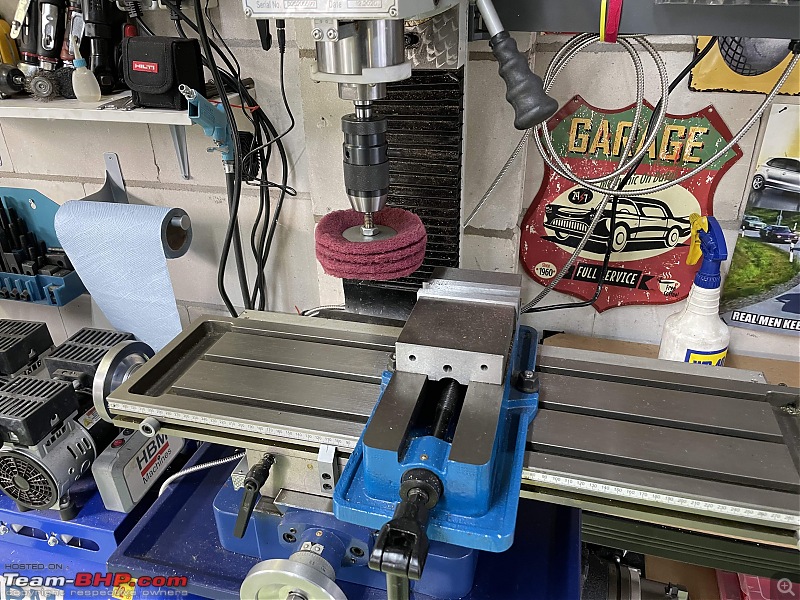 After the scothbrite treatment you clean the parts with brake cleaner fluid. Next you line them up and add so called flux. The flux will ensure the molten filler will flow along the material. You can either add it during the heating process, or whenever possible, put bits of filler along the joint. This is the preferred method 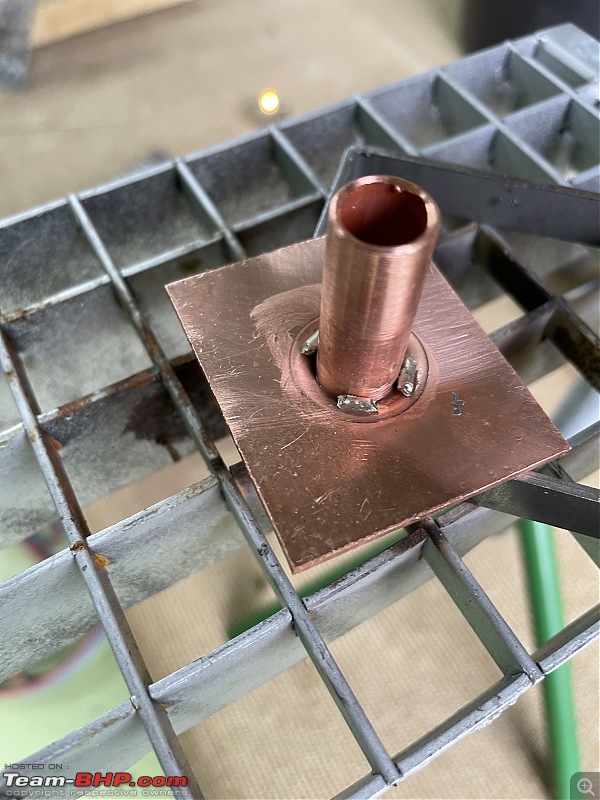 Next you need to have a good burner with a hot enough flame. Setting the flame to the correct settings is a bit of a challenge. Then you basically heat up the material. Once the flux starts boiling you need to watch very carefully as soon the filler will start to melt and flow as well. If you have done it all correctly the filler will be spread around, very smoothly along the joint. 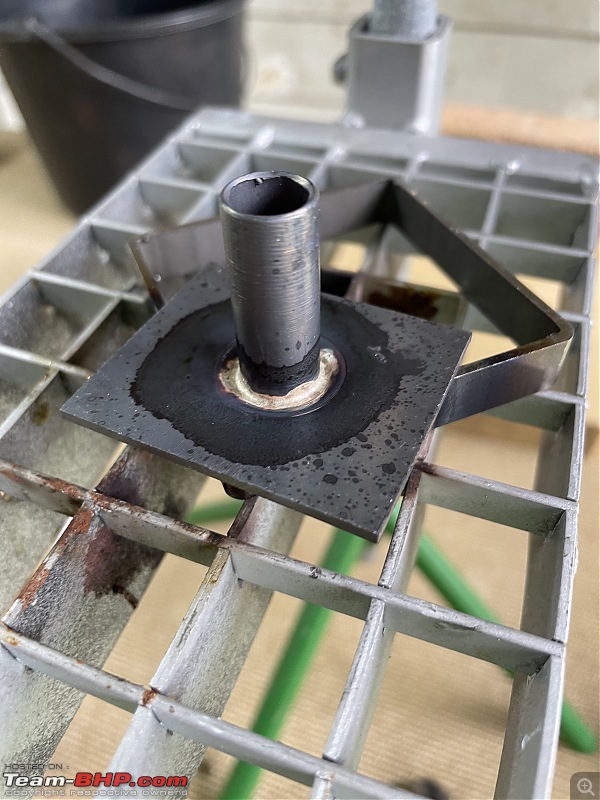 And also, it should penetrate all the way to the other side as well. 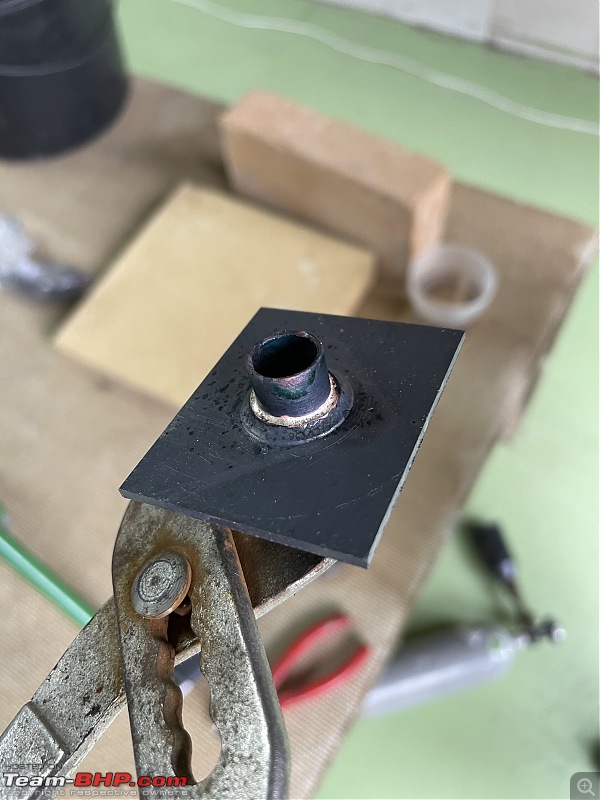 Simple enough, but many variables. Also, the type of material, thickness, different is size of the two parts you want to join all require different approaches on how you set up the pieces and how you braze them. Having multiple brace joints close together is always a challenge. You put to much heat into the second joint the first one might start to flow again. After you are done with the joint it needs to cool down. You let it cool down naturally. Putting it in water will make the joint brittle. Also, you will need to clean everything if you want it to look nice. We did not bother with the cleaning part. We concentrated on the actual brazing only. So we tried different materials, with different kinds of joints etc. 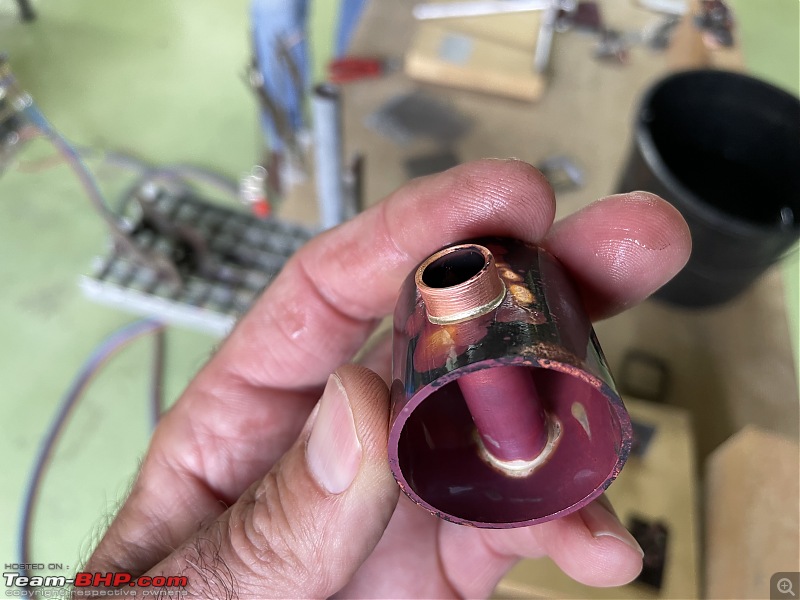 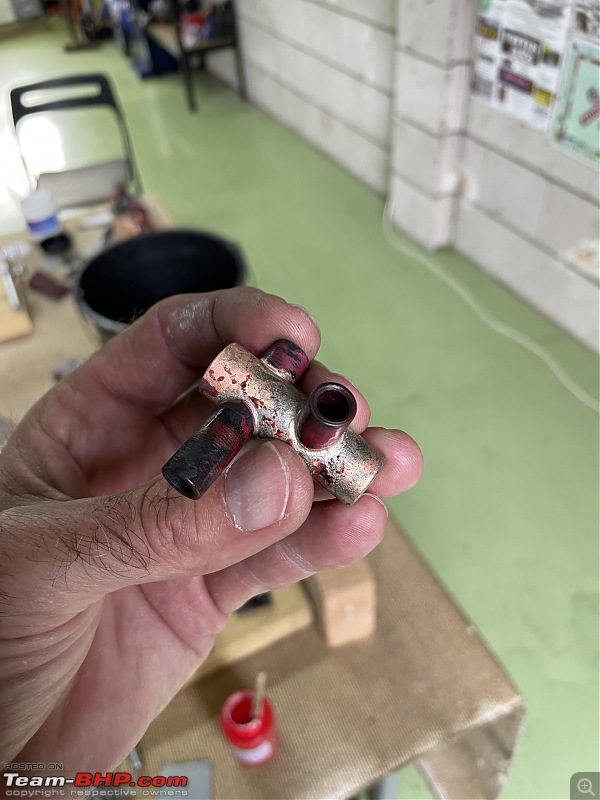 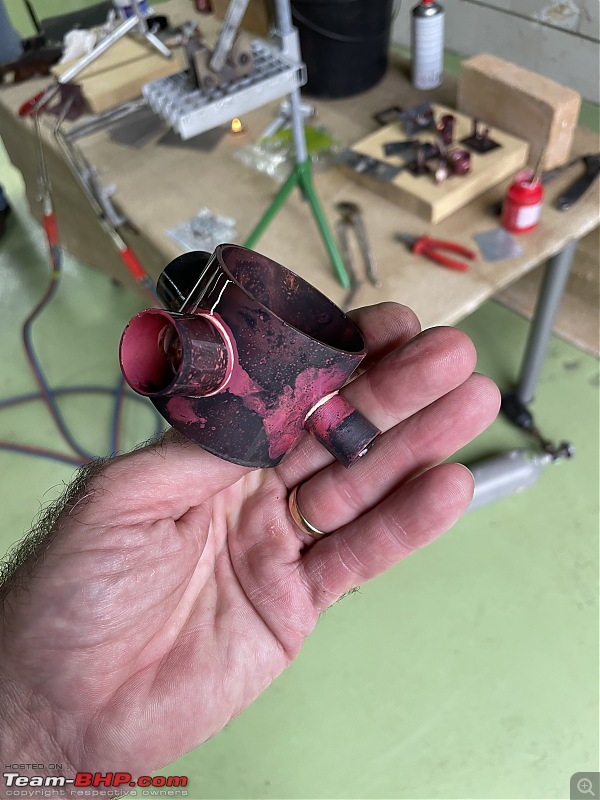 Both Ruud and I became better during the day and we made good progress. Brazing is a very good technique for all kinds of materials. We tried it out on metal, brass, copper, aluminium and even stainless steel. We had compared notes before on what kind of challenges and problems we had come across earlier during our own home brazing. And discussed with our teacher, who put together a very comprehensive program where just about all these aspects were dealt with. Both Ruud and I also came to the conclusion that we need to get ourselves a better burner. The ones we are using here are butane / oxygen. But you can also get them suitable for compressed air and butane. Which means I can just use my compressor and the gas tank from the barbecue. The flame needs to have sufficient heat so you can heat up the materials quickly. If it takes too long, the flux will burn off and the filler simply wonít flow. Typically, of course, the larger/heavier the object is you want to braze the more heat you need. There are endless different types of flux and fillers, depending on the application. Here yours truly doing some brazing! 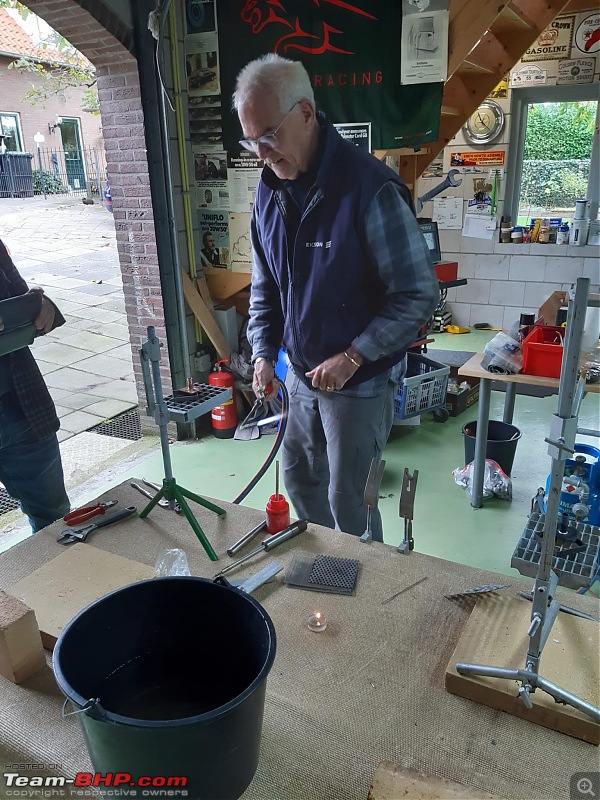 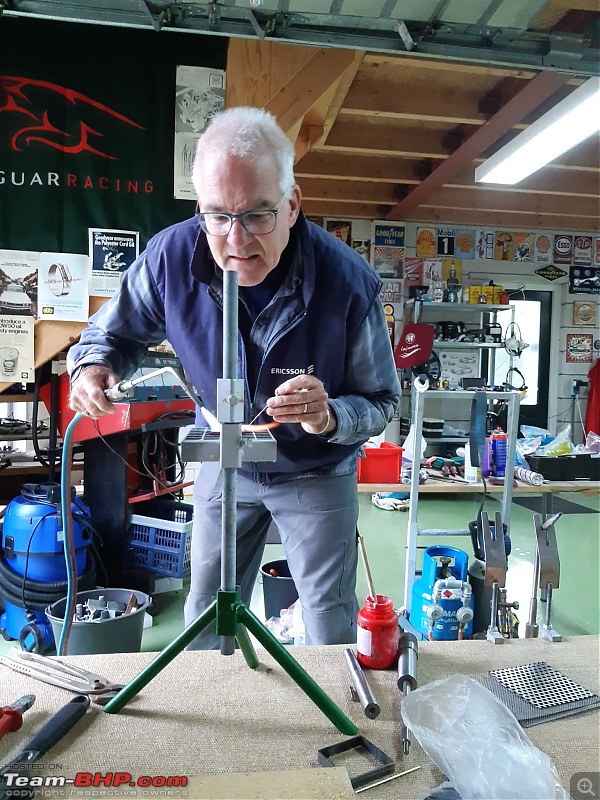 The three of us had a very pleasant and hugely interesting day. I will be using brazing on my model engine builds, but also on some of the repairs on my cars and or tools. For instance, the exhaust manifold on the W123 has a crack in it. They all do, they were never manufactured properly. Brazing is an excellent technique to fix it. Jeroen |
| |  (16)
Thanks (16)
Thanks
 |
| The following 16 BHPians Thank Jeroen for this useful post: | anoopelias, dailydriver, digitalnirvana, Gannu_1, GreenerPlanet, gururajrv, IcarusMan, InControl, keroo1099, knockout, Prowler, SanjayW, SS-Traveller, Thad E Ginathom, VinsWagen, VivekCherian |
| | #989 | ||||||||||
| Distinguished - BHPian  Join Date: Jun 2007 Location: Chennai
Posts: 11,005
Thanked: 26,447 Times
| Re: My Car Hobby: A lot of fiddling, and some driving too! Jaguar XJR, Mercedes W123 & Alfa Romeo Sp Quote:
Quote:
Quote:
Quote:
Hard soldering is a step closer to welding. But welding actually heats the metals to a point where they flow and fuse (even with the help of a filler) whereas hard/soft soldering does not. Please comment: I don't have welding experience, and you do. Quote:
Quote:
I think that with brazing, one can actually fill gaps and even build up metal, as can be done with welding. With jewellery (gold/silver/etc) we say that the solder is not a gap filler. The parts fit must be very good. But if it is too good, there is nowhere for the solder to flow, and that will fail. Quote:
Quote:
Quote:
Quote:
I loved this stuff, and still get a thrill reading and writing about it now, a couple of decades since I last did any. As Jeroen says, the basic process is not that difficult, but their is infinite scope for better results and wider experience. Small parts, as in hobby-craft jewellery can be silver-soldered with a butane-can torch. But the dangers should not be underestimated. A brazing torch flame does not spend much time warning with pain before it burns human tissue. Metal parts that have recently been red hot no longer show visible warnings, but will cause major burns. Last edited by Thad E Ginathom : 6th November 2022 at 15:39. | ||||||||||
| |  (8)
Thanks (8)
Thanks
 |
| The following 8 BHPians Thank Thad E Ginathom for this useful post: | dailydriver, digitalnirvana, IcarusMan, InControl, Jeroen, Prowler, SS-Traveller, VinsWagen |
| | #990 | |||||||
| Distinguished - BHPian  | Re: My Car Hobby: A lot of fiddling, and some driving too! Jaguar XJR, Mercedes W123 & Alfa Romeo Sp Quote:
Yes, correct, most cars will draw some power. This is a 1998 car, with electronic control of various system (it has a PCM) and one of the first simple bus-systems connecting the various electronic components. I donít understand why that should remain powered on. The only components I have identified so far that require continuous power are the radio and the resettable-day counter. On most radioís you will require a continuous plus to keep the memory settings. These days, almost all cars have a build in sound system. But those of us who have been adding radioís to cars over the last decades will be familiar with it. Most radio would have a minus (mass), permanent 12V+, 12v+ via ignition and possible another 12V+ for the automatic/retractable antenna. I donít worry about the 26mA. But I like to understand what is it that is powered by it. The 1A with the key in the ACC position is definitely high. Or at least without understanding what is powered. Although, in this position, you can operate the radio and the power windows, I donít see anything else being switched on, so what is drawing that one amp? The windows are operated by simple three way switches, so no electronics involved there as far as I can see. I have been looking at the electrical diagrams, but I find it very hard these days to make sense of those. So I am going to pull all the fuses one by one and see what that does to the amps. Stand by for an update later this week. Quote:
Quote:
Quote:
Quote:
Quote:
Quote:
Jeroen | |||||||
| |  (3)
Thanks (3)
Thanks
 |
| The following 3 BHPians Thank Jeroen for this useful post: | Prowler, SS-Traveller, Thad E Ginathom |
 |


